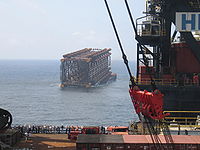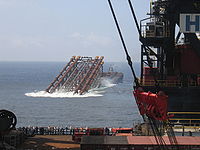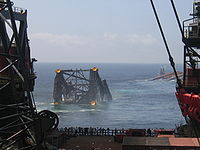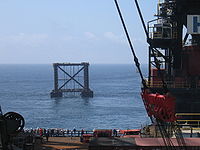
An oil platform is a large structure with facilities to extract and process petroleum and natural gas that lie in rock formations beneath the seabed. Many oil platforms will also have facilities to accommodate the workers, although it is also common to have a separate accommodation platform bridge linked to the production platform. Most commonly, oil platforms engage in activities on the continental shelf, though they can also be used in lakes, inshore waters, and inland seas. Depending on the circumstances, the platform may be fixed to the ocean floor, consist of an artificial island, or float. In some arrangements the main facility may have storage facilities for the processed oil. Remote subsea wells may also be connected to a platform by flow lines and by umbilical connections. These sub-sea facilities may include one or more subsea wells or manifold centres for multiple wells.

Offshore construction is the installation of structures and facilities in a marine environment, usually for the production and transmission of electricity, oil, gas and other resources. It is also called maritime engineering.
Petronius is a deepwater compliant tower oil platform built from 1997 to 2000 and operated by Chevron in the Gulf of Mexico, 210 km (130.5 mi) southeast of New Orleans, United States.

A floating production storage and offloading (FPSO) unit is a floating vessel used by the offshore oil and gas industry for the production and processing of hydrocarbons, and for the storage of oil. An FPSO vessel is designed to receive hydrocarbons produced by itself or from nearby platforms or subsea template, process them, and store oil until it can be offloaded onto a tanker or, less frequently, transported through a pipeline. FPSOs are preferred in frontier offshore regions as they are easy to install, and do not require a local pipeline infrastructure to export oil. FPSOs can be a conversion of an oil tanker or can be a vessel built specially for the application. A vessel used only to store oil is referred to as a floating storage and offloading (FSO) vessel.

A tension-leg platform (TLP) or extended tension leg platform (ETLP) is a vertically moored floating structure normally used for the offshore production of oil or gas, and is particularly suited for water depths greater than 300 metres and less than 1500 metres. Use of tension-leg platforms has also been proposed for offshore wind turbines.
Baldpate is a 579.7 metres (1,902 ft) offshore compliant tower oil platform near the coast of Louisiana, owned and operated by Hess Corporation. It was the first freestanding compliant tower to be built following the Lena platform which was a guyed compliant tower. It is the second tallest structure built in water after the Petronius. The Baldpate Platform was designed and built by Hudson Engineering in Houston, Texas, and installed by Heerema Marine Contractors.

Bullwinkle was a 1,736 feet (529 m) tall, pile-supported fixed steel oil platform in the Gulf of Mexico. Installed in 1988, the total weight of the platform was 77,000 tons, of which the steel jacket comprises 49,375 tones. At the time of its construction it was the third tallest freestanding structure ever built – shorter than only the CN Tower and the Ostankino Tower – and the tallest in the United States, being 6 ft (1.8 m) taller than the pinnacle of the Sears Tower. Of the total height, 1,352 feet (412 m) are below the waterline. It is located in Green Canyon Block 65, approximately 160 miles (260 km) southwest of New Orleans. Bullwinkle currently is operated by QuarterNorth Energy, LLC. The total field development construction cost was US$500,000,000 according to some sources.
"Offshore", when used in relation to hydrocarbons, refers to operations undertaken at, or under the, sea in association with an oil, natural gas or condensate field that is under the seabed, or to activities carried out in relation to such a field. Offshore is part of the upstream sector of the oil and gas industry.

A jackup rig or a self-elevating unit is a type of mobile platform that consists of a buoyant hull fitted with a number of movable legs, capable of raising its hull over the surface of the sea. The buoyant hull enables transportation of the unit and all attached machinery to a desired location. Once on location the hull is raised to the required elevation above the sea surface supported by the sea bed. The legs of such units may be designed to penetrate the sea bed, may be fitted with enlarged sections or footings, or may be attached to a bottom mat. Generally jackup rigs are not self-propelled and rely on tugs or heavy lift ships for transportation.
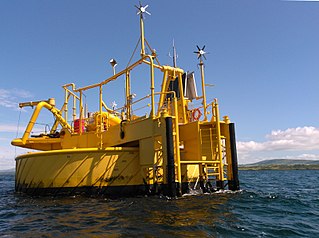
A Single buoy mooring (SrM) is a loading buoy anchored offshore, that serves as a mooring point and interconnect for tankers loading or offloading gas or liquid products. SPMs are the link between geostatic subsea manifold connections and weathervaning tankers. They are capable of handling any tonnage ship, even very large crude carriers (VLCC) where no alternative facility is available.
Deepwater drilling, or deep well drilling, is the process of creating holes in the Earth's crust using a drilling rig for oil extraction under the deep sea. There are approximately 3400 deepwater wells in the Gulf of Mexico with depths greater than 150 meters.

A fixed platform is a type of offshore platform used for the extraction of petroleum or gas. These platforms are built on concrete and/or steel legs anchored directly onto the seabed, supporting a deck with space for drilling rigs, production facilities and crew quarters. Such platforms are, by virtue of their immobility, designed for very long-term use. Various types of structure are used, steel jacket, concrete caisson, floating steel and even floating concrete. Steel jackets are vertical sections made of tubular steel members, and are usually piled into the seabed. Concrete caisson structures, pioneered by the Condeep concept, often have in-built oil storage in tanks below the sea surface and these tanks were often used as a flotation capability, allowing them to be built close to shore and then floated to their final position where they are sunk to the seabed. Fixed platforms are economically feasible for installation in water depths up to about 500 feet ; for deeper depths a floating production system, or a subsea pipeline to land or to shallower water depths for processing, would usually be considered.
Offshore concrete structures, or concrete offshore structures, are structures built from reinforced concrete for use in the offshore marine environment. They serve the same purpose as their steel counterparts in oil and gas production and storage. The first concrete oil platform was installed in the North Sea in the Ekofisk oil field in 1973 by Phillips Petroleum, and they have become a significant part of the marine construction industry. Since then at least 47 major concrete offshore structures have been built.
Roncador oil field is a large oil and gas field located in the Campos Basin, 125 km (78 mi) off the coast of Brazil, northeast from Rio de Janeiro. It covers a 111 km2 (43 sq mi) area and reaches depths between 1,500 and 1,900 metres.

Suction caissons are a form of fixed platform anchor in the form of an open bottomed tube embedded in the sediment and sealed at the top while in use so that lifting forces generate a pressure differential that holds the caisson down. They have a number of advantages over conventional offshore foundations, mainly being quicker to install than deep foundation piles and being easier to remove during decommissioning. Suction caissons are now used extensively worldwide for anchoring large offshore installations, like oil platforms, offshore drillings and accommodation platforms to the seafloor at great depths. In recent years, suction caissons have also seen usage for offshore wind turbines in shallower waters.
A steel catenary riser (SCR) is a common method of connecting a subsea pipeline to a deepwater floating or fixed oil production platform. SCRs are used to transfer fluids like oil, gas, injection water, etc. between the platforms and the pipelines.
Benguela-Belize Lobito-Tomboco is a 512 m (1,680 ft) offshore compliant tower oil platform off the coast of Angola, located in water 390 m (1,280 ft) deep in the lower Congo basin. It is owned and run by the Chevron Corporation.


